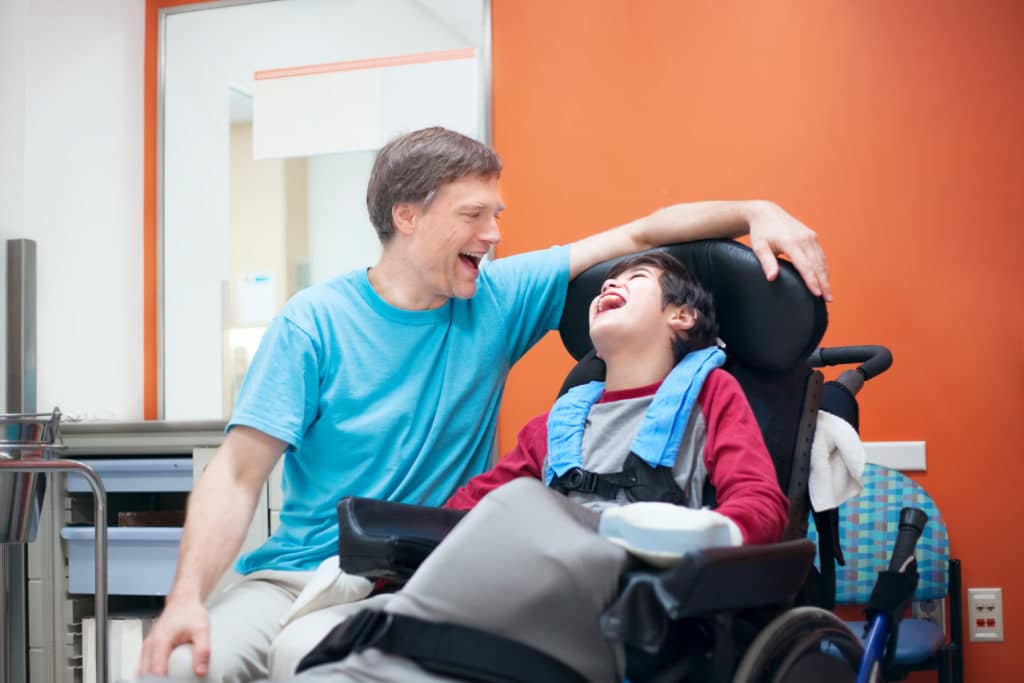By Ziba Kashef from BabyCenter.com (Last updated: April 2017)
If your child hasn’t already encountered a person with a disability, it’s likely he will at some point in school, where children with special needs are often in the same classroom with other kids. Be ready: Your curious grade-schooler will probably ask lots of questions.
How you respond is likely to affect the way your child thinks about disabilities and treats others as he grows up. It’s also an opportunity for you to foster an attitude of inclusion and acceptance.
How to talk to your child about disabilities
Address your child’s curiosity. If you notice your child staring, take the lead. You might say, “I noticed you saw that little girl has a harder time walking than you do. She has cerebral palsy, which makes her muscles work a little differently.”
Ask if your child has questions. If you know the person with the disability, ask her yourself or let your child ask. Laura Pope of San Francisco, whose 7-year-old son, Jake, has Down syndrome, says, “Kids and parents can totally ask anything they want – it’s preferable to blank stares.”
Be matter-of-fact. Susan Linn, a psychologist at the Judge Baker Children’s Center at Harvard Medical School, suggests that you avoid emotion or going into detail. She offers this response to a question about a person in a wheelchair: “I imagine he may be having problems with his legs. He can’t walk.”
Know your child is listening. Take care in how you describe people with disabilities. Avoid outdated, derogatory terms like “crippled,” “retarded,” and “handicapped.”
Separate the person from the condition. Say “the child who has autism” versus “the autistic child.” Also, avoid referring to nondisabled kids as “normal,” since it implies abnormality or a defect in others.
When you and your child encounter someone with a disability, there’s no need to say things like “Don’t stare” or “Let’s keep moving.” People with disabilities may feel stigmatized by those who avoid them, and your child might get the impression that he can’t ask you questions.
Instead, when your child stares and says, “What’s wrong with that lady?” simply explain that the person walks or communicates in a different way.
Emphasize what’s the same. A kid may be disabled, but he’s still a kid. Talk to your child about what a classmate or neighbor with a disability has in common with others – the same age, school, or favorite sport.
Teach awareness and sensitivity. If your child starts asking detailed questions, offer to help him find answers at home. Go online together to learn more about a particular disability. Be sure to not only point out what people with disabilities can’t do but what they can.
“Children need to learn that just because a child may be physically impaired does not mean he’s mentally impaired,” says Jacqueline Lambert-Kupstas, mom of a boy with kyphosis, a spinal deformity. “These children understand what’s going on around them.”
Don’t allow jokes or bullying. Kids with special needs are more likely to be bullied and abused in every way – they’re just easier targets. If you hear your child or her friends referring to another kid or adult as “dumb” or “retarded,” explain just how much those words hurt. Teach her to apologize when she has hurt another child’s feelings.
Answers to your child’s questions about disabilities
“Why doesn’t she talk like me?” If you know the answer or can guess, tell your child in terms she’ll understand: “She has trouble with the muscles that make it easy to talk.”
“Is he retarded or something?” Let your child know that “retarded” is not a nice word and say, “His brain works differently, so he has a harder time talking and learning than you do. But otherwise, he’s just like everyone else.”
“Why does he act like that?” Talk about how people with disabilities sometimes struggle with different things. For example, tell your child how hard it is for a kid with autism to communicate and how frustrating that can be. “Some of these children have outbursts not because they’re being bad but because they can’t get across their thoughts and feelings,” says Lambert-Kupstas.
“Why doesn’t he go to our school?” Explain that some kids need to go to a school that can give them extra help with reading, writing, walking, talking, or playing with others.
“Why did that happen to him?” Be matter-of-fact and explain that some people are born with disabilities, and others get hurt or sick and become disabled.
What else you can do
Model acceptance and inclusion by reaching out to those with disabilities. Say hello at the playground, church, and school.
Encourage your child to develop friendships with children who have disabilities. Arrange playdates or have your child join a school or after-school program that includes children with disabilities.
Review your child’s book and media collection. If it doesn’t have characters with disabilities or if the treatment of characters with disabilities seems outdated, add some fresh additions to the mix.
Be open to classroom inclusion. Many elementary schools integrate children with disabilities into the classroom. You may fear this takes too much of the teacher’s attention away from your own kid. But your child stands to gain, too. For example, he demonstrates kindness and maturity when he can help another child with homework or push a classmate’s wheelchair. And even more importantly, he’ll probably gain a new friend.
